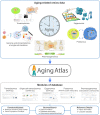Aging Atlas: a multi-omics database for aging biology
- PMID: 33119753
- PMCID: PMC7779027
- DOI: 10.1093/nar/gkaa894
Aging Atlas: a multi-omics database for aging biology
Abstract
Organismal aging is driven by interconnected molecular changes encompassing internal and extracellular factors. Combinational analysis of high-throughput 'multi-omics' datasets (gathering information from genomics, epigenomics, transcriptomics, proteomics, metabolomics and pharmacogenomics), at either populational or single-cell levels, can provide a multi-dimensional, integrated profile of the heterogeneous aging process with unprecedented throughput and detail. These new strategies allow for the exploration of the molecular profile and regulatory status of gene expression during aging, and in turn, facilitate the development of new aging interventions. With a continually growing volume of valuable aging-related data, it is necessary to establish an open and integrated database to support a wide spectrum of aging research. The Aging Atlas database aims to provide a wide range of life science researchers with valuable resources that allow access to a large-scale of gene expression and regulation datasets created by various high-throughput omics technologies. The current implementation includes five modules: transcriptomics (RNA-seq), single-cell transcriptomics (scRNA-seq), epigenomics (ChIP-seq), proteomics (protein-protein interaction), and pharmacogenomics (geroprotective compounds). Aging Atlas provides user-friendly functionalities to explore age-related changes in gene expression, as well as raw data download services. Aging Atlas is freely available at https://bigd.big.ac.cn/aging/index.
© The Author(s) 2020. Published by Oxford University Press on behalf of Nucleic Acids Research.
Figures

References
-
- Zhang W., Qu J., Liu G.-H., Belmonte J.C.I.. The ageing epigenome and its rejuvenation. Nat. Rev. Mol. Cell Bio. 2020; 21:137–150. - PubMed
-
- Yoshimoto S., Mun Loo T., Hara E.. Cellular senescence and liver cancer: a gut microbial connection. Inflamm. Regener. 2015; 35:106–113.
Publication types
MeSH terms
LinkOut - more resources
Full Text Sources
Medical

